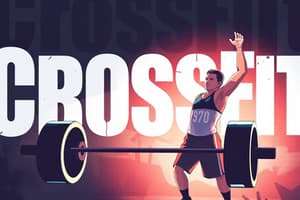Podcast
Questions and Answers
What is a key characteristic of a well-defined goal according to the provided guidelines?
What is a key characteristic of a well-defined goal according to the provided guidelines?
- It should focus on what not to do in training.
- It must be expressed in positive tense. (correct)
- It should avoid any reference to negative outcomes.
- It must be vague to allow for flexibility.
Which factor is essential for making a goal achievable?
Which factor is essential for making a goal achievable?
- It should be vague and general.
- It must include an unrealistic time frame.
- It needs to be challenging yet realistic. (correct)
- It must express a negative intention.
How should goals be constructed to ensure clarity?
How should goals be constructed to ensure clarity?
- The goal should focus on past failures.
- The goal needs to be concise and specific. (correct)
- The goal should include multiple objectives.
- The goal must be stated in a negative format.
Which of the following exemplifies an appropriately structured goal?
Which of the following exemplifies an appropriately structured goal?
What aspect is NOT essential when setting goals in the context described?
What aspect is NOT essential when setting goals in the context described?
How can an athlete best assist a coach in developing a training plan for achieving 50 consecutive pull-ups?
How can an athlete best assist a coach in developing a training plan for achieving 50 consecutive pull-ups?
What is the primary goal of a CrossFit coach when helping athletes set fitness targets?
What is the primary goal of a CrossFit coach when helping athletes set fitness targets?
What role does an athlete's initial performance level play in setting their pull-up goals?
What role does an athlete's initial performance level play in setting their pull-up goals?
What consequence might occur if an athlete does not disclose their current pull-up performance?
What consequence might occur if an athlete does not disclose their current pull-up performance?
Which aspect is crucial for a CrossFit coach to consider in the timeline for an athlete's goal?
Which aspect is crucial for a CrossFit coach to consider in the timeline for an athlete's goal?
What impact does a coach's reinforcement have on an athlete during workouts?
What impact does a coach's reinforcement have on an athlete during workouts?
What was the coach's unintentional effect when he said, 'the next 50 miles will be the hardest yet'?
What was the coach's unintentional effect when he said, 'the next 50 miles will be the hardest yet'?
Why is positive reinforcement considered crucial for CrossFit coaches?
Why is positive reinforcement considered crucial for CrossFit coaches?
What does the speaker imply about athletes during workouts?
What does the speaker imply about athletes during workouts?
What lesson did the speaker learn during the experience of running 100 miles?
What lesson did the speaker learn during the experience of running 100 miles?
Flashcards
Goal
Goal
A specific, desired end state expressed in the positive tense, providing motivation and direction for achievement.
Goal Setting - Point 1
Goal Setting - Point 1
Goals must be concise and specific.
Goal Setting - Point 2
Goal Setting - Point 2
Goals should be expressed in the positive tense.
Goal Setting - Point 3
Goal Setting - Point 3
Signup and view all the flashcards
CrossFit Goal Setting Uniqueness
CrossFit Goal Setting Uniqueness
Signup and view all the flashcards
Athlete's Current Ability
Athlete's Current Ability
Signup and view all the flashcards
Goal Setting Balance
Goal Setting Balance
Signup and view all the flashcards
Setting Time Frames
Setting Time Frames
Signup and view all the flashcards
CrossFit Coach's Role
CrossFit Coach's Role
Signup and view all the flashcards
Goal Achievement's Impact
Goal Achievement's Impact
Signup and view all the flashcards
Coach's Influence
Coach's Influence
Signup and view all the flashcards
Positive Reinforcement
Positive Reinforcement
Signup and view all the flashcards
Negative Reinforcement
Negative Reinforcement
Signup and view all the flashcards
Athlete Impressionability
Athlete Impressionability
Signup and view all the flashcards
Coach's Perspective
Coach's Perspective
Signup and view all the flashcards
Study Notes
Coaching the Mental Side of CrossFit
- CrossFit founder, Coach Greg Glassman, emphasized the importance of mental adaptation for success.
- Top CrossFit athletes exhibit controlled self-talk, resulting in consistent goal achievement.
- Positive self-talk leads to optimism, mental toughness, and an indomitable spirit.
- Coaches must understand and shape athlete self-talk and goal-setting.
- Teaching positive self-talk and realistic goal setting is crucial for athlete success.
Defining a Goal
- A goal is a desired end state, expressed positively, motivating achievement.
- A goal must be concise, specific, and in the affirmative.
- Inclusion of a realistic yet challenging time frame is essential.
- Specific goals enable precise planning and evaluation of achievement.
- Positive wording fosters positive mental states and enhances athletic performance.
Goal Setting: Three Key Performance Points
- Specific: Goals need clear definitions for effective planning and evaluation of progress.
- Positive: Use positive language to promote progress and confidence.
- Realistic & Achievable: Time frames should balance challenge and realistic accomplishment, allowing for continual progress.
Goal Setting: Coach-Athlete Collaboration
- Athletes and coaches need to agree upon the specific desired outcome.
- Realistic timeframe assessment is crucial, considering current abilities.
- Timeframes must be realistic, yet provide challenge and motivation for progress.
- Coaching ensures athletes have the tools to define and complete smaller, incremental milestones towards larger goals
The Power of Positive Self-Talk
- Athletes are impressionable during workouts.
- Positive reinforcement before, during, and after workouts is vital.
- Coaches should utilize the most receptive moments for positive messaging.
- Words and comments from coaches have a significant, potentially influencing effect on athletes.
- Positive reinforcement cues athlete's technique and range of motion.
- Example: Instead of saying, "You're rounding your back," use "Maintain your lumbar curve."
- Example: Instead of "missed the bottom of the squat," use "Drive two inches deeper."
Scripting Self-Talk
- Legendary fight trainer, John Hackleman, emphasizes scripting positive self-talk.
- Coaches should use positive, motivating language during crucial moments.
- Example: Instead of saying "You're not tired," say "You look strong. I am proud of you!"
Practical Coaching Strategies
- Use whiteboards and personal journals to track goals and progress.
- Encourage public goal setting for trust and accountability.
- Ask about athletes' aspirations and assist in goal formulation.
- Publicly acknowledge goal achievements to reinforce positive reinforcement.
- Listen to athletes' self-talk and politely correct negativity.
Studying That Suits You
Use AI to generate personalized quizzes and flashcards to suit your learning preferences.




